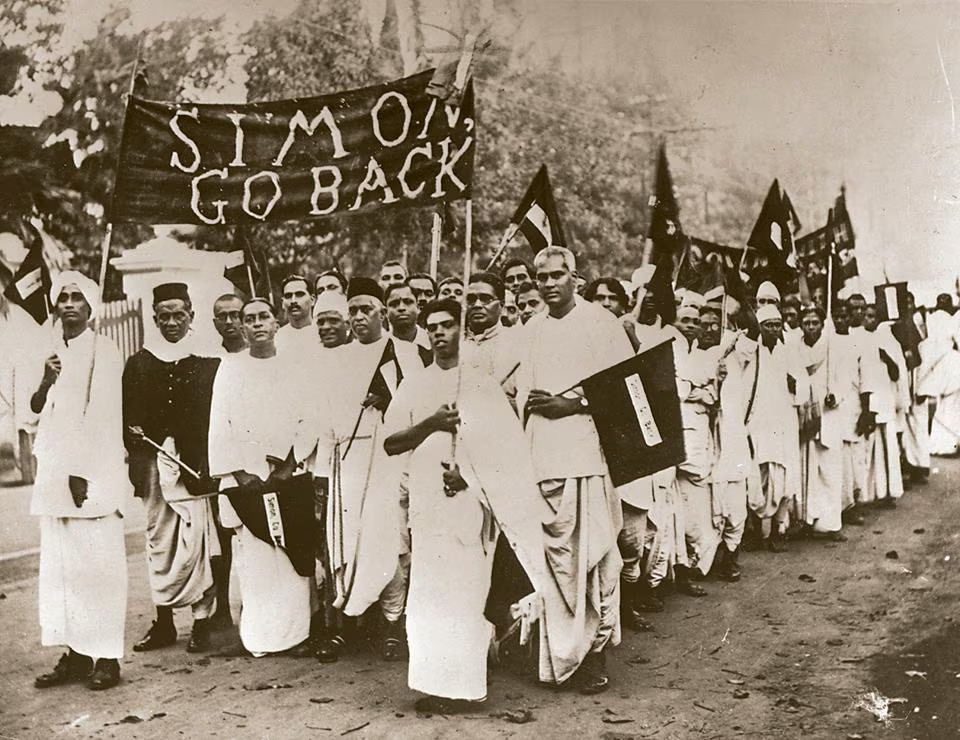The Arrival of the Simon Commission in India: A Turning Point in the Freedom Struggle
History Indian HistoryPosted by NewAdmin on 2025-02-06 08:51:45 |
Share: Facebook | Twitter | Whatsapp | Linkedin Visits: 11

The Simon Commission arrived in India on February 3, 1928, during British colonial rule. It was a seven-member commission appointed by the British government under the chairmanship of Sir John Simon to assess the political situation in India and recommend constitutional reforms. The commission was formed as part of Britain's effort to evaluate the working of the Government of India Act of 1919 and suggest changes for the future governance of the country.
One of the major controversies surrounding the Simon Commission was that it did not include a single Indian member. All its members were British parliamentarians, which angered Indian leaders across political groups. The exclusion of Indians was seen as an insult, as it denied them the right to participate in discussions about their own country's political future. This led to widespread protests across India, with people uniting under the slogan "Simon Go Back."
When the commission arrived in Bombay, it was met with black flags, protests, and demonstrations led by political leaders from the Indian National Congress as well as other groups. The opposition to the commission was not limited to Congress leaders but also included other political factions, including the Muslim League and the Hindu Mahasabha, which opposed the idea of an all-British body deciding India's fate.
One of the most significant events linked to the Simon Commission was the protest led by Lala Lajpat Rai in Lahore on October 30, 1928. During this demonstration, the police, under the orders of James A. Scott, launched a brutal lathi charge on the protesters. Lala Lajpat Rai was severely injured and later succumbed to his injuries on November 17, 1928. His death intensified the revolutionary movement in India, with young revolutionaries like Bhagat Singh and his associates deciding to avenge his death by targeting British officials.
Despite the protests, the Simon Commission continued its work and later submitted its report in 1930. The report recommended the continuation of British rule with minor constitutional changes, but it failed to address India's demand for self-governance. It was eventually rejected by Indian political leaders, leading to further movements for complete independence.
The arrival of the Simon Commission and the resistance it faced played a crucial role in uniting Indians against British rule. It also highlighted the growing demand for self-rule, setting the stage for future events like the Nehru Report and the demand for complete independence in the Lahore Session of 1929.
Search
Categories
- Sports
- Business
- History
- Politics
- International
- Science & Technology
- Social Issues
- Disaster Management
- Current Affairs
- Education
- Startup Business
- Startup News
- Awards
- Community Services
- Fundraising Events
- Volunteer Services
- Health Initiatives
- Innovations and Initiatives
- In News
- dummybanners
- Awards
- Partners
- Products
- Press Releases
- News
- Fast Check
- South
- సినిమా
- Gallery
- Sunday Chronicle
- Hyderabad Chronicle
- లైఫ్ స్టైల్
- National
- క్రైం
- ట్రెండింగ్
- జాబ్స్
- అంతర్జాతీయo
- బిజినెస్
- రాజకీయం
- బిజినెస్
- సంపాదకీయం
- నవ్య
- చిత్ర జ్యోతి
- క్రీడలు
- జాతీయం
- తెలంగాణ
- తాజా వార్తలు
- మన పార్టీ
- మన నాయకత్వం
- మన విజయాలు
- డౌన్లోడ్స్
- మీడియా వనరులు
- కార్యకర్తలు
- North East Skill Center News
- Government Schemes
- Entrepreneurship Support
- Employment Opportunities
- Skill Training Programs
- Departments
- Investments
- Initiatives
- Resources
- Telangana IT Parks
- Events & Jobs
- Press Releases
- News
- Airport News
- Newtons Laws of Motion
- Karbonn in Business
- Investments in Karbonn
- Company quarterly sales
- Markets
- Auto News
- Industry
- Money
- Advertisements
- Stock target
- Company Updates
- Stock Market
- Company Sales
- Staffing and HR
- Constituency Assembly
- General News
- Srikalahasti Temple
- Bojjala Sudhir Reddy
- Technology & Innovation
- Sports
- Business
- Products
- Industries
- Services & Trainings
- Tools & Resources
- Technology Integration
- Drug Seizures & Arrests
- Telangana Narcotics
- Law & Enforcement
- Rehabilitation
- Nationwide Drug Policing
- Nigeria Seizures
- Global Operations
- Drug Awareness
- Drug Enforcement Tech
- NCB Drug Seizures
- Judicial Crackdown
- India's Surveillance Tools
- Cross-Border Links
- Women Safety
- Cyber Crimes
- Drug Abuse
- Traffic & Road Safety
- Community Connect
- Public Safety Alerts
- Citizen Assistance
- Nellore City News
- Politics & Administration
- Events & Festivals
- Agriculture & Rural
- Business & Economy
- Health & Wellness
Recent News
- eBay's talent pool drives expansion to Bengaluru
- Shocking Turn of Events for Trump Supporter Arrested for Threatening his Life
- How a bistable gene unlocks the mysteries of a deadly bacterium
- Spain Battles Record Wildfires, With Over 400,000 Hectares Already Burnt
- Karnataka HC Orders State to Consider Bike Taxi Ban, Citing Precedent and Livelihood
- China's Declining Emissions Spark Hope for Cleaner Future
- Church Moved to Make Way for Mining, Resettles after 2-Day Journey
- Hurricane Erin Causes Beach Closures And Concerns For Coastal Communities